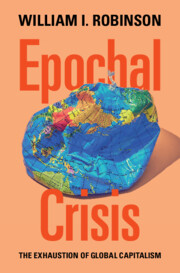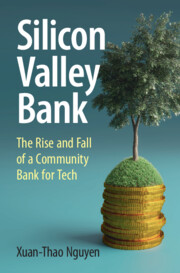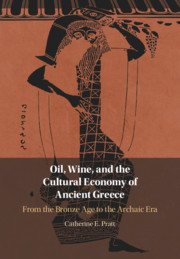Refine search
Actions for selected content:
39 results
Chapter 29 - Triage and Prioritisation on Labour Wards
-
-
- Book:
- Best Practice in Labour and Delivery
- Published online:
- 16 October 2025
- Print publication:
- 06 November 2025, pp 368-378
-
- Chapter
- Export citation

Epochal Crisis
- The Exhaustion of Global Capitalism
-
- Published online:
- 21 August 2025
- Print publication:
- 04 September 2025
Systemic contributions to global catastrophic risk
- Part of
-
- Journal:
- Global Sustainability / Volume 8 / 2025
- Published online by Cambridge University Press:
- 23 June 2025, e19
-
- Article
-
- You have access
- Open access
- HTML
- Export citation
Theatre of War and Prospects for Peace on the Korean Peninsula on the Anniversary of the Yeonpyeong Incident
-
- Journal:
- Asia-Pacific Journal / Volume 9 / Issue 51 / December 2011
- Published online by Cambridge University Press:
- 07 May 2025, e1
-
- Article
-
- You have access
- Open access
- Export citation
1 - Precious Metal Coinages at Rome and in the Provinces
-
- Book:
- The Roman Provinces, 300 BCE–300 CE
- Published online:
- 14 November 2024
- Print publication:
- 14 November 2024, pp 1-43
-
- Chapter
- Export citation
9 - Shelley in the Overgrowth
-
-
- Book:
- Percy Shelley for Our Times
- Published online:
- 07 March 2024
- Print publication:
- 14 March 2024, pp 195-213
-
- Chapter
-
- You have access
- Open access
- HTML
- Export citation

Silicon Valley Bank
- The Rise and Fall of a Community Bank for Tech
-
- Published online:
- 08 February 2024
- Print publication:
- 15 February 2024
Isotopic evidence of an environmental shift at the fall of the Kushite kingdom of Meroë, Sudan
-
- Article
-
- You have access
- Open access
- HTML
- Export citation
FROM REGIONS TO THE WORLD: GLOBAL CRISES FROM THE THIRD CENTURY TO TODAY
-
- Journal:
- Social Philosophy and Policy / Volume 40 / Issue 2 / Winter 2023
- Published online by Cambridge University Press:
- 14 May 2024, pp. 455-481
- Print publication:
- Winter 2023
-
- Article
- Export citation
3 - Sensemaking
-
- Book:
- Frontline Crisis Response
- Published online:
- 28 September 2023
- Print publication:
- 12 October 2023, pp 31-48
-
- Chapter
- Export citation
Different strategies in Indus agriculture: the goals and outcomes of farming choices
-
- Article
-
- You have access
- Open access
- HTML
- Export citation
7 - Toggling the System
-
- Book:
- COVID and Climate Emergencies in the Majority World
- Published online:
- 22 June 2023
- Print publication:
- 06 July 2023, pp 62-72
-
- Chapter
- Export citation
Climate change intensified violence in the south-central Andean highlands from 1.5 to 0.5 ka
-
- Journal:
- Quaternary Research / Volume 115 / September 2023
- Published online by Cambridge University Press:
- 05 June 2023, pp. 109-119
-
- Article
-
- You have access
- Open access
- HTML
- Export citation
2 - Extinction … or Survival?
-
- Book:
- How to Fix a Broken Planet
- Published online:
- 15 January 2023
- Print publication:
- 05 January 2023, pp 12-27
-
- Chapter
- Export citation
4 - Pulses in an Electromagnetic Field
- from Part II - On the Rural
-
- Book:
- The Rural Landscapes of Archaic Cyprus
- Published online:
- 18 February 2023
- Print publication:
- 15 December 2022, pp 113-153
-
- Chapter
- Export citation
Lessons Learned From the Collapse of the Metropole Building, Iran, 2022
-
- Journal:
- Disaster Medicine and Public Health Preparedness / Volume 17 / 2023
- Published online by Cambridge University Press:
- 02 November 2022, e232
-
- Article
-
- You have access
- HTML
- Export citation
10 - Collapse
-
- Book:
- A Primer on Theoretical Soil Mechanics
- Published online:
- 14 July 2022
- Print publication:
- 04 August 2022, pp 69-81
-
- Chapter
- Export citation
10 - Reclaiming Human Nature
- from Part III - Back to the Future
-
- Book:
- Ultrasocial
- Published online:
- 09 October 2021
- Print publication:
- 26 August 2021, pp 193-214
-
- Chapter
- Export citation

Oil, Wine, and the Cultural Economy of Ancient Greece
- From the Bronze Age to the Archaic Era
-
- Published online:
- 19 March 2021
- Print publication:
- 18 March 2021
6 - Effects of Disasters
-
- Book:
- Disasters and History
- Published online:
- 06 October 2020
- Print publication:
- 22 October 2020, pp 123-158
-
- Chapter
-
- You have access
- Open access
- HTML
- Export citation
